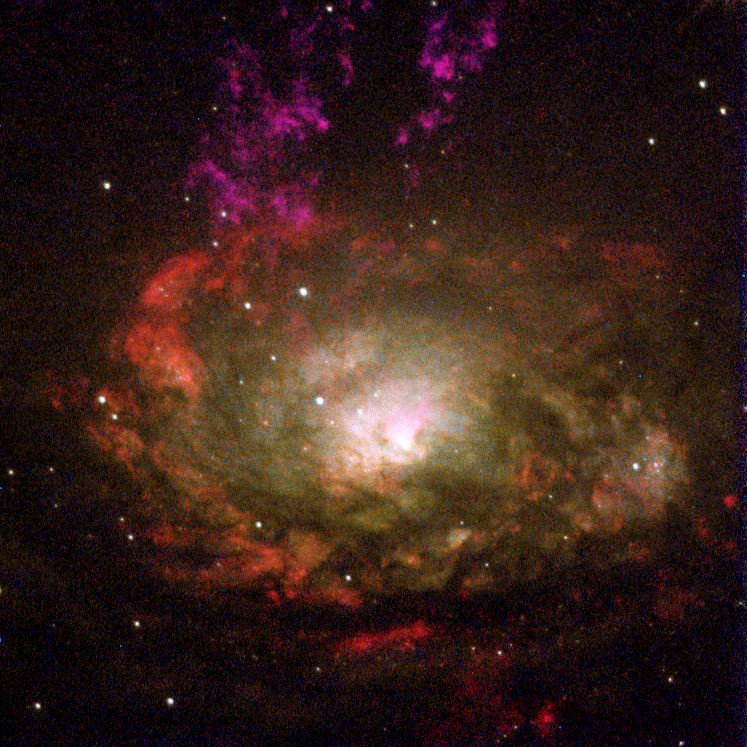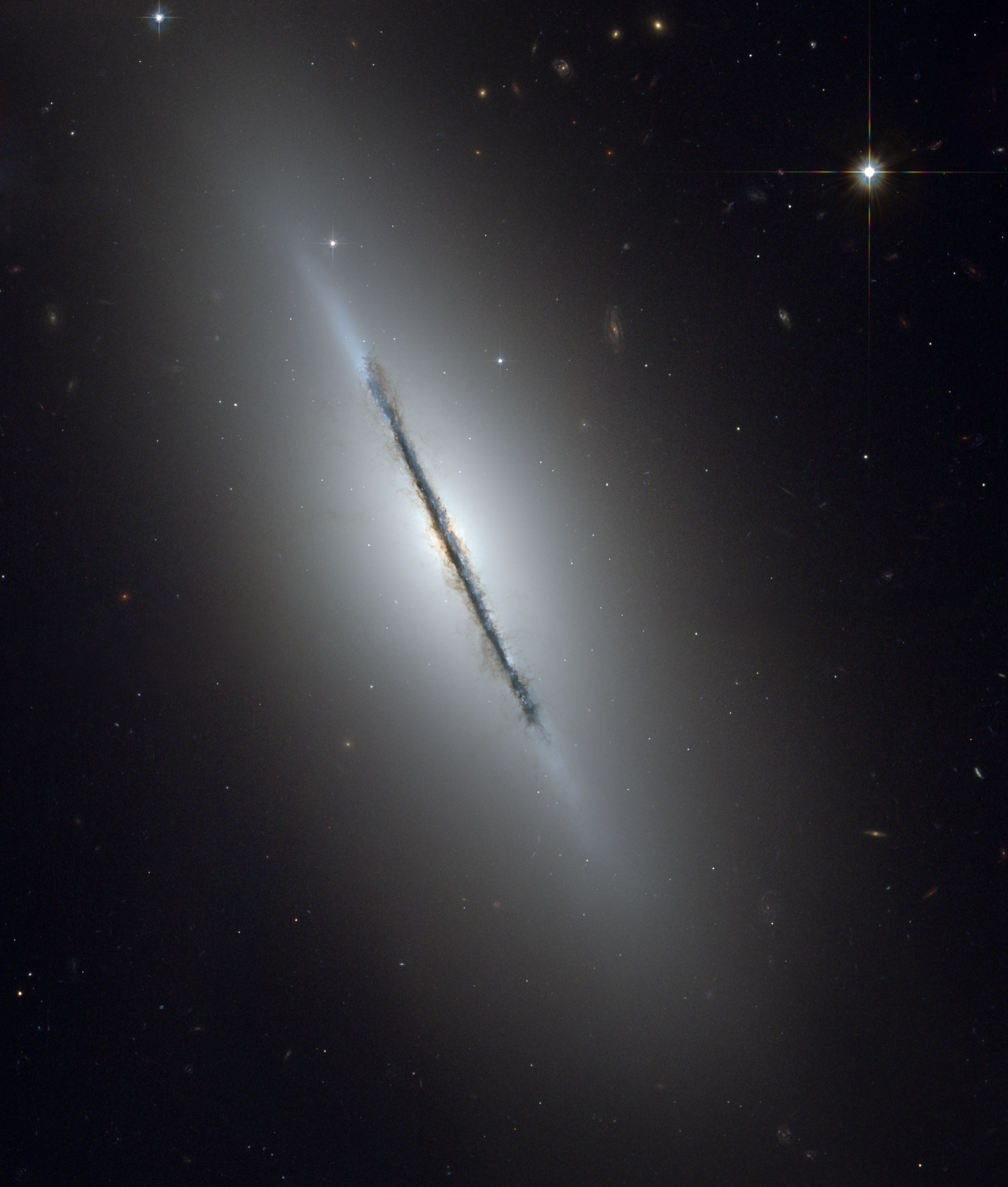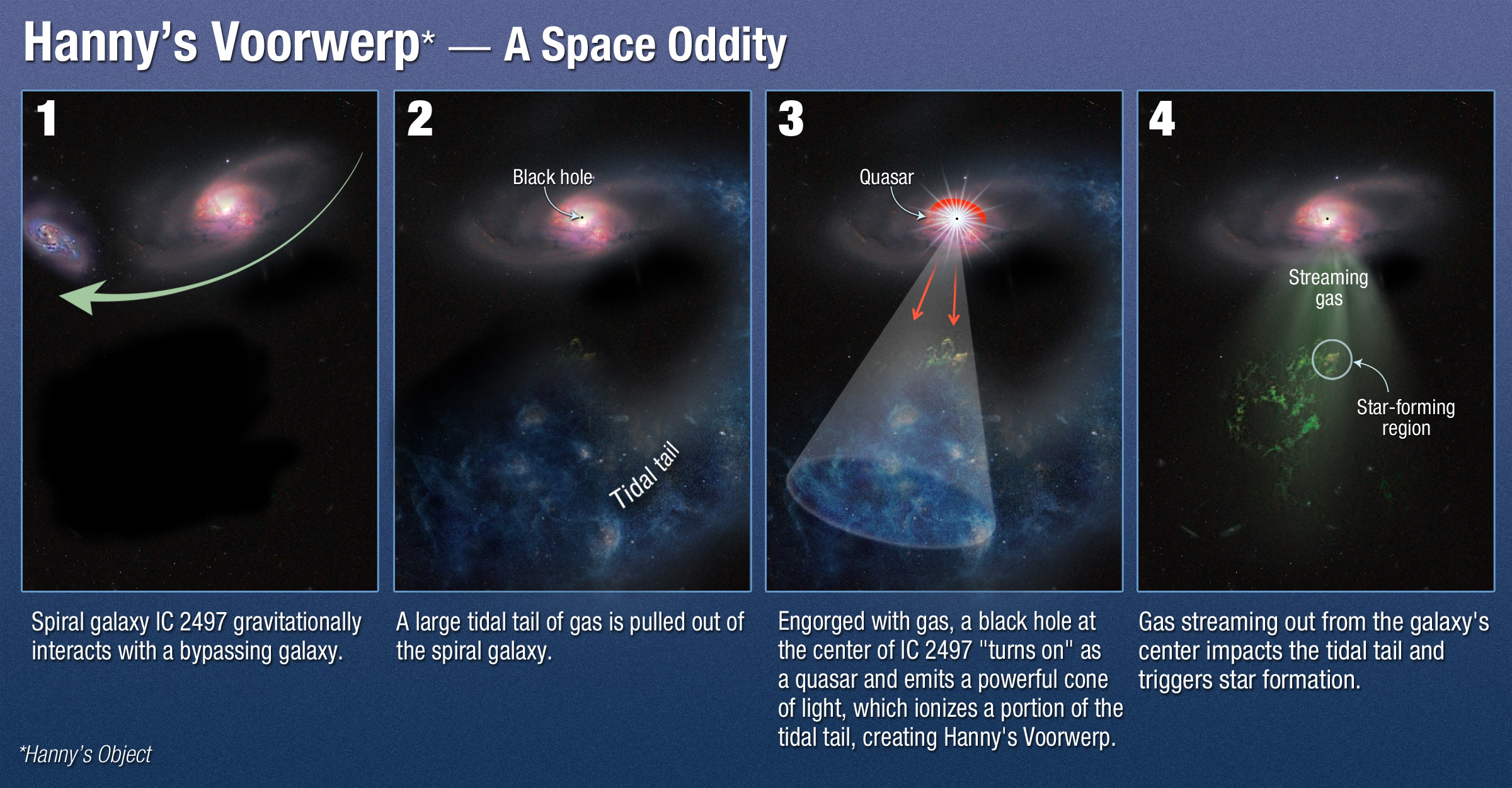|
NGC 5252
NGC 5252 is a lenticular galaxy located in the constellation Virgo. It is located at a distance of about 220 to 320 million light years from Earth, which, given its apparent dimensions, means that NGC 5252 is about 100,000 light years across. It was discovered by William Herschel on February 2, 1786. Characteristics Nucleus The nucleus of NGC 5252 has been found to be active and it has been categorised as a type II Seyfert galaxy or type 1.9. A broad H-alpha line has been observed, indicating that a broad line region is partially hidden and the nucleus of NGC 5252 is more active than originally thought. The most accepted theory for the energy source of active galactic nuclei is the presence of an accretion disk around a supermassive black hole. The mass of the black hole in the centre of NGC 5252 is estimated to be based on the dynamics of the circumnuclear gas. The mass of the black hole is larger than that observed in Seyfert galaxies and it is more in line with a ... [...More Info...] [...Related Items...] OR: [Wikipedia] [Google] [Baidu] |
New General Catalogue
The ''New General Catalogue of Nebulae and Clusters of Stars'' (abbreviated NGC) is an astronomical catalogue of deep-sky objects compiled by John Louis Emil Dreyer in 1888. The NGC contains 7,840 objects, including galaxies, star clusters and emission nebulae. Dreyer published two supplements to the NGC in 1895 and 1908, known as the ''Index Catalogues'' (abbreviated IC), describing a further 5,386 astronomical objects. Thousands of these objects are best known by their NGC or IC numbers, which remain in widespread use. The NGC expanded and consolidated the cataloguing work of William and Caroline Herschel, and John Herschel's ''General Catalogue of Nebulae and Clusters of Stars''. Objects south of the celestial equator are catalogued somewhat less thoroughly, but many were included based on observation by John Herschel or James Dunlop. The NGC contained multiple errors, but attempts to eliminate them were made by the ''Revised New General Catalogue'' (RNGC) by Jack W. Sulent ... [...More Info...] [...Related Items...] OR: [Wikipedia] [Google] [Baidu] |
Seyfert Galaxy
Seyfert galaxies are one of the two largest groups of active galaxies, along with quasars. They have quasar-like nuclei (very luminous, distant and bright sources of electromagnetic radiation) with very high surface brightnesses whose spectra reveal strong, high-ionisation emission lines, but unlike quasars, their host galaxies are clearly detectable. Seyfert galaxies account for about 10% of all galaxies and are some of the most intensely studied objects in astronomy, as they are thought to be powered by the same phenomena that occur in quasars, although they are closer and less luminous than quasars. These galaxies have supermassive black holes at their centers which are surrounded by accretion discs of in-falling material. The accretion discs are believed to be the source of the observed ultraviolet radiation. Ultraviolet emission and absorption lines provide the best diagnostics for the composition of the surrounding material. Seen in visible light, most Seyfert galaxies ... [...More Info...] [...Related Items...] OR: [Wikipedia] [Google] [Baidu] |
NGC Objects
The ''New General Catalogue of Nebulae and Clusters of Stars'' (abbreviated NGC) is an astronomical catalogue of deep-sky objects compiled by John Louis Emil Dreyer in 1888. The NGC contains 7,840 objects, including galaxies, star clusters and emission nebulae. Dreyer published two supplements to the NGC in 1895 and 1908, known as the ''Index Catalogues'' (abbreviated IC), describing a further 5,386 astronomical objects. Thousands of these objects are best known by their NGC or IC numbers, which remain in widespread use. The NGC expanded and consolidated the cataloguing work of William and Caroline Herschel, and John Herschel's ''General Catalogue of Nebulae and Clusters of Stars''. Objects south of the celestial equator are catalogued somewhat less thoroughly, but many were included based on observation by John Herschel or James Dunlop. The NGC contained multiple errors, but attempts to eliminate them were made by the ''Revised New General Catalogue'' (RNGC) by Jack W. Sulenti ... [...More Info...] [...Related Items...] OR: [Wikipedia] [Google] [Baidu] |
Seyfert Galaxies
Seyfert galaxies are one of the two largest groups of active galaxies, along with quasars. They have quasar-like nuclei (very luminous, distant and bright sources of electromagnetic radiation) with very high surface brightnesses whose spectra reveal strong, high-ionisation emission lines, but unlike quasars, their host galaxies are clearly detectable. Seyfert galaxies account for about 10% of all galaxies and are some of the most intensely studied objects in astronomy, as they are thought to be powered by the same phenomena that occur in quasars, although they are closer and less luminous than quasars. These galaxies have supermassive black holes at their centers which are surrounded by accretion discs of in-falling material. The accretion discs are believed to be the source of the observed ultraviolet radiation. Ultraviolet emission and absorption lines provide the best diagnostics for the composition of the surrounding material. Seen in visible light, most Seyfert galaxies ... [...More Info...] [...Related Items...] OR: [Wikipedia] [Google] [Baidu] |
Lenticular Galaxies
A lenticular galaxy (denoted S0) is a type of galaxy intermediate between an elliptical (denoted E) and a spiral galaxy in galaxy morphological classification schemes. It contains a large-scale disc but does not have large-scale spiral arms. Lenticular galaxies are disc galaxies that have used up or lost most of their interstellar matter and therefore have very little ongoing star formation. They may, however, retain significant dust in their disks. As a result, they consist mainly of aging stars (like elliptical galaxies). Despite the morphological differences, lenticular and elliptical galaxies share common properties like spectral features and scaling relations. Both can be considered early-type galaxies that are passively evolving, at least in the local part of the Universe. Connecting the E galaxies with the S0 galaxies are the ES galaxies with intermediate-scale discs. Morphology and structure Classification Lenticular galaxies are unique in that they have a visibl ... [...More Info...] [...Related Items...] OR: [Wikipedia] [Google] [Baidu] |
Hanny's Voorwerp
, (Dutch for ''Hanny's object'') is a rare type of astronomical object called a quasar ionization echo. It was discovered in 2007 by Dutch schoolteacher Hanny van Arkel while she was participating as a volunteer in the Galaxy Zoo project, part of the Zooniverse group of citizen science websites. Photographically, it appears as a bright blob close to spiral galaxy IC 2497 in the constellation Leo Minor. Description Hanny's Voorwerp (HsV) is about the size of a small galaxy and has a central hole over 16,000 light years across. In an image taken with the Hubble Space Telescope, HsV is colored green, a standard false color that is used to represent the presence of several luminous emission lines of glowing oxygen. HsV has been shown to be at the same distance from Earth as the adjacent galaxy IC 2497, which is about 650 million light-years away. Star birth is occurring in the region of HsV that faces IC 2497. Radio observations indicate that this is due to an outflow of gas from ... [...More Info...] [...Related Items...] OR: [Wikipedia] [Google] [Baidu] |
Dwarf Galaxy
A dwarf galaxy is a small galaxy composed of about 1000 up to several billion stars, as compared to the Milky Way's 200–400 billion stars. The Large Magellanic Cloud, which closely orbits the Milky Way and contains over 30 billion stars, is sometimes classified as a dwarf galaxy; others consider it a full-fledged galaxy. Dwarf galaxies' formation and activity are thought to be heavily influenced by interactions with larger galaxies. Astronomers identify numerous types of dwarf galaxies, based on their shape and composition. Formation One theory states that most galaxies, including dwarf galaxies, form in association with dark matter, or from gas that contains metals. However, NASA's Galaxy Evolution Explorer space probe identified new dwarf galaxies forming out of gases with low metallicity. These galaxies were located in the Leo Ring, a cloud of hydrogen and helium around two massive galaxies in the constellation Leo. Because of their small size, dwarf galaxies have ... [...More Info...] [...Related Items...] OR: [Wikipedia] [Google] [Baidu] |
Intermediate-mass Black Hole
An intermediate-mass black hole (IMBH) is a class of black hole with mass in the range 102–105 solar masses: significantly more than stellar black holes but less than the 105–109 solar mass supermassive black holes. Several IMBH candidate objects have been discovered in our galaxy and others nearby, based on indirect gas cloud velocity and accretion disk spectra observations of various evidentiary strength. Observational evidence The gravitational wave signal GW190521, which occurred on 21 May 2019 at 03:02:29 UTC, and was published on 2 September 2020, resulted from the merger of two black holes, weighing 85 and 65 solar masses, with the resulting black hole weighing 142 solar masses, and 8 solar masses being radiated away as gravitational waves. Before that, the strongest evidence for IMBHs comes from a few low-luminosity active galactic nuclei. Due to their activity, these galaxies almost certainly contain accreting black holes, and in some cases the black hole masses c ... [...More Info...] [...Related Items...] OR: [Wikipedia] [Google] [Baidu] |
Ultraluminous X-ray Source
An ultraluminous X-ray source (ULX) is an astronomical source of X-rays that is less luminous than an active galactic nucleus but is more consistently luminous than any known stellar process (over 1039 erg/s, or 1032 watts), assuming that it radiates isotropically (the same in all directions). Typically there is about one ULX per galaxy in galaxies which host them, but some galaxies contain many. The Milky Way has not been shown to contain a ULX, although SS 433 may be a possible source. The main interest in ULXs stems from their luminosity exceeding the Eddington luminosity of neutron stars and even stellar black holes. It is not known what powers ULXs; models include beamed emission of stellar mass objects, accreting intermediate-mass black holes, and super-Eddington emission. Observational facts ULXs were first discovered in the 1980s by the Einstein Observatory. Later observations were made by ROSAT. Great progress has been made by the X-ray observatories XMM-Newton and Chan ... [...More Info...] [...Related Items...] OR: [Wikipedia] [Google] [Baidu] |
Ionization Cone
Ionization cones are cones of ionized material extending from active galactic nuclei, predominantly observed in type II Seyfert galaxies. They are detected through their emission of electromagnetic radiation in the visible and infrared parts of the spectrum. The main method of observation is through spectroscopy, using spectral line analysis to measure the shape of the ionized region and the condition of the material such as temperature, density, composition, and degree of ionization. Characteristics Shape Ionization cones have a distinct conical shape, with the galactic center at the apex. Galaxies with ionization cones are thought to have a dense torus-like structure surrounding the central black hole, co-planar with the accretion disk. The material in this torus, consisting of interstellar gas and dust, obstructs the photons coming from the inner area around the black hole and prevents ionization of the galactic matter outside the torus. Along the symmetry axis, howe ... [...More Info...] [...Related Items...] OR: [Wikipedia] [Google] [Baidu] |
Spectrum
A spectrum (plural ''spectra'' or ''spectrums'') is a condition that is not limited to a specific set of values but can vary, without gaps, across a continuum. The word was first used scientifically in optics to describe the rainbow of colors in visible light after passing through a prism. As scientific understanding of light advanced, it came to apply to the entire electromagnetic spectrum. It thereby became a mapping of a range of magnitudes (wavelengths) to a range of qualities, which are the perceived "colors of the rainbow" and other properties which correspond to wavelengths that lie outside of the visible light spectrum. Spectrum has since been applied by analogy to topics outside optics. Thus, one might talk about the " spectrum of political opinion", or the "spectrum of activity" of a drug, or the "autism spectrum". In these uses, values within a spectrum may not be associated with precisely quantifiable numbers or definitions. Such uses imply a broad range of condition ... [...More Info...] [...Related Items...] OR: [Wikipedia] [Google] [Baidu] |
Quasar
A quasar is an extremely Luminosity, luminous active galactic nucleus (AGN). It is pronounced , and sometimes known as a quasi-stellar object, abbreviated QSO. This emission from a galaxy nucleus is powered by a supermassive black hole with a mass ranging from millions to tens of billions of solar masses, surrounded by a gaseous accretion disc. Gas in the disc falling towards the black hole heats up because of friction and releases energy in the form of electromagnetic radiation. The radiant energy of quasars is enormous; the most powerful quasars have luminosity, luminosities thousands of times greater than that of a galaxy such as the Milky Way. Usually, quasars are categorized as a subclass of the more general category of AGN. The redshifts of quasars are of Expansion of the universe, cosmological origin. The term originated as a Contraction (grammar), contraction of "quasi-stellar ''[star-like]'' radio source"—because quasars were first identified during the 1950s as sour ... [...More Info...] [...Related Items...] OR: [Wikipedia] [Google] [Baidu] |







.jpg)


